Recognition of Foal Nursing Behavior Based on an Improved RT-DETR Model
Simple Summary
Abstract
1. Introduction
2. Materials and Methods
2.1. Definition of Foal Nursing Behavior Labels
2.2. Experiment and Data Collection
2.3. Dataset Creation
2.4. Model Implementation
2.4.1. The Framework for Foal Nursing Behavior Recognition
2.4.2. SACGNet
2.4.3. AIFI-MCSA
2.5. Foal Suckling Time Statistics
2.6. Evaluation Metrics
3. Experiments and Results
3.1. Experimental Environment
3.2. Model Performance Analysis
3.2.1. Performance Evaluation
3.2.2. RT-DETR-Foalnursing vs. Other Models
3.2.3. Ablation Experiment
3.2.4. Feature Learning Visualization
3.3. Recognition Result Analysis
3.3.1. Foal Suckling Behavior Recognition Results
3.3.2. Foal Suckling Behavior Time Statistical Analysis
3.3.3. Foal Suckling Posture Time Statistics and Analysis
4. Discussion
4.1. Recognition of Foal Suckling Behavior in Backlit and Low-Light Environments
4.2. Fine-Grained Recognition of Foal Suckling Behavior
4.3. Statistical Analysis of Multiple Foals’ Suckling Time
5. Conclusions
Author Contributions
Funding
Institutional Review Board Statement
Informed Consent Statement
Data Availability Statement
Conflicts of Interest
References
- Becvarova, I.; Buechner-Maxwell, V. Feeding the Foal for Immediate and Long-Term Health. Equine Vet. J. 2012, 44 (Suppl. S41), 149–156. [Google Scholar] [CrossRef]
- Henry, S.; Sigurjónsdóttir, H.; Klapper, A.; Joubert, J.; Montier, G.; Hausberger, M. Domestic Foal Weaning: Need for Re-Thinking Breeding Practices? Animals 2020, 10, 361. [Google Scholar] [CrossRef] [PubMed]
- Tyler, S.J. The behaviour and social organisation of the New Forest ponies. Anim. Behav. Monogr. 1972, 5, 85–196. [Google Scholar] [CrossRef]
- Li, G.; Shi, G.; Zhu, C. Dynamic Serpentine Convolution with Attention Mechanism Enhancement for Beef Cattle Behavior Recognition. Animals 2024, 14, 466. [Google Scholar] [CrossRef]
- Jia, Q.; Yang, J.; Han, S.; Du, Z.; Liu, J. CAMLLA-YOLOv8n: Cow Behavior Recognition Based on Improved YOLOv8n. Animals 2024, 14, 3033. [Google Scholar] [CrossRef]
- Tong, L.; Fang, J.; Wang, X.; Zhao, Y. Research on Cattle Behavior Recognition and Multi-Object Tracking Algorithm Based on YOLO-BoT. Animals 2024, 14, 2993. [Google Scholar] [CrossRef]
- Mu, Y.; Hu, J.; Wang, H.; Li, S.; Zhu, H.; Luo, L.; Wei, J.; Ni, L.; Chao, H.; Hu, T.; et al. Research on the Behavior Recognition of Beef Cattle Based on the Improved Lightweight CBR-YOLO Model Based on YOLOv8 in Multi-Scene Weather. Animals 2024, 14, 2800. [Google Scholar] [CrossRef]
- Fuentes, A.; Han, S.; Nasir, M.F.; Park, J.; Yoon, S.; Park, D.S. Multiview Monitoring of Individual Cattle Behavior Based on Action Recognition in Closed Barns Using Deep Learning. Animals 2023, 13, 2020. [Google Scholar] [CrossRef] [PubMed]
- Li, J.; Liu, Y.; Zheng, W.; Chen, X.; Ma, Y.; Guo, L. Monitoring Cattle Ruminating Behavior Based on an Improved Keypoint Detection Model. Animals 2024, 14, 1791. [Google Scholar] [CrossRef] [PubMed]
- Bai, Q.; Gao, R.; Wang, R.; Li, Q.; Yu, Q.; Zhao, C.; Li, S. X3DFast Model for Classifying Dairy Cow Behaviors Based on a Two-Pathway Architecture. Sci. Rep. 2023, 13, 20519. [Google Scholar] [CrossRef] [PubMed]
- Hao, W.; Han, M.; Zhang, K.; Zhang, L.; Hao, W.; Li, F.; Liu, Z. Novel Method for the Recognition of Jinnan Cattle Action Using Bottleneck Attention Enhanced Two-Stream Neural Network. Int. J. Agric. Biol. Eng. 2024, 17, 203–210. [Google Scholar] [CrossRef]
- Hua, Z.; Wang, Z.; Xu, X.; Kong, X.; Song, H. An Effective PoseC3D Model for Typical Action Recognition of Dairy Cows Based on Skeleton Features. Comput. Electron. Agric. 2023, 212, 108152. [Google Scholar] [CrossRef]
- Arablouei, R.; Bishop-Hurley, G.J.; Bagnall, N.; Ingham, A. Cattle Behavior Recognition from Accelerometer Data: Leveraging In-Situ Cross-Device Model Learning. Comput. Electron. Agric. 2024, 227, 109546. [Google Scholar] [CrossRef]
- Yu, L.; Guo, J.; Pu, Y.; Cen, H.; Li, J.; Liu, S.; Nie, J.; Ge, J.; Yang, S.; Zhao, H.; et al. A Recognition Method of Ewe Estrus Crawling Behavior Based on Multi-Target Detection Layer Neural Network. Animals 2023, 13, 413. [Google Scholar] [CrossRef]
- Wan, Z.; Tian, F.; Zhang, C. Sheep Face Recognition Model Based on Deep Learning and Bilinear Feature Fusion. Animals 2023, 13, 1957. [Google Scholar] [CrossRef] [PubMed]
- Xu, Y.; Nie, J.; Cen, H.; Wen, B.; Liu, S.; Li, J.; Ge, J.; Yu, L.; Pu, Y.; Song, K.; et al. Spatio-Temporal-Based Identification of Aggressive Behavior in Group Sheep. Animals 2023, 13, 2636. [Google Scholar] [CrossRef] [PubMed]
- Gu, Z.; Zhang, H.; He, Z.; Niu, K. A Two-Stage Recognition Method Based on Deep Learning for Sheep Behavior. Comput. Electron. Agric. 2023, 212, 108143. [Google Scholar] [CrossRef]
- Pang, Y.; Yu, W.; Zhang, Y.; Xuan, C.; Wu, P. An Attentional Residual Feature Fusion Mechanism for Sheep Face Recognition. Sci. Rep. 2023, 13, 17128. [Google Scholar] [CrossRef]
- Zhang, L.; Zhao, B.; He, C.; Yang, F.; Zhang, J. Behaviour Recognition of Housed Sheep Based on Spatio-Temporal Information. J. Appl. Anim. Res. 2024, 52, 1–13. [Google Scholar] [CrossRef]
- Wang, R.; Gao, R.; Li, Q.; Dong, J. Pig Face Recognition Based on Metric Learning by Combining a Residual Network and Attention Mechanism. Agriculture 2023, 13, 144. [Google Scholar] [CrossRef]
- Zhuang, Y.; Zhou, K.; Zhou, Z.; Ji, H.; Teng, G. Systems to Monitor the Individual Feeding and Drinking Behaviors of Growing Pigs Based on Machine Vision. Agriculture 2023, 13, 103. [Google Scholar] [CrossRef]
- Zhou, H.; Li, Q.; Xie, Q. Individual Pig Identification Using Back Surface Point Clouds in 3D Vision. Sensors 2023, 23, 5156. [Google Scholar] [CrossRef] [PubMed]
- Ji, H.; Teng, G.; Yu, J.; Wen, Y.; Deng, H.; Zhuang, Y. Efficient Aggressive Behavior Recognition of Pigs Based on Temporal Shift Module. Animals 2023, 13, 2078. [Google Scholar] [CrossRef] [PubMed]
- Hao, W.; Zhang, K.; Zhang, L.; Han, M.; Hao, W.; Li, F.; Yang, G. TSML: A New Pig Behavior Recognition Method Based on Two-Stream Mutual Learning Network. Sensors 2023, 23, 5092. [Google Scholar] [CrossRef]
- Bai, Y.; Zhang, J.; Chen, Y.; Yao, H.; Xin, C.; Wang, S.; Yu, J.; Chen, C.; Xiao, M.; Zou, X. Research into Heat Stress Behavior Recognition and Evaluation Index for Yellow-Feathered Broilers, Based on Improved Cascade Region-Based Convolutional Neural Network. Agriculture 2023, 13, 1114. [Google Scholar] [CrossRef]
- Teterja, D.; Garcia-Rodriguez, J.; Azorin-Lopez, J.; Sebastian-Gonzalez, E.; Nedić, D.; Leković, D.; Knežević, P.; Drajić, D.; Vukobratović, D. A Video Mosaicing-Based Sensing Method for Chicken Behavior Recognition on Edge Computing Devices. Sensors 2024, 24, 3409. [Google Scholar] [CrossRef]
- Hu, S.; Hou, R.; Liao, Z.; Chen, P. Recognition and Location of Marine Animal Sounds Using Two-Stream ConvNet with Attention. Front. Mar. Sci. 2023, 10, 1059622. [Google Scholar] [CrossRef]
- Nishioka, K.; Noguchi, W.; Izuka, H.; Yamamoto, M. Detecting Eating Behavior of Elephants in a Zoo Using Temporal Action Localization. Sens. Mater. 2023, 35, 3927–3945. [Google Scholar] [CrossRef]
- Martin-Cirera, A.; Nowak, M.; Norton, T.; Auer, U.; Oczak, M. Comparison of Transformers with LSTM for Classification of the Behavioural Time Budget in Horses Based on Video Data. Biosyst. Eng. 2024, 242, 154–168. [Google Scholar] [CrossRef]
- Liu, Y.; Zhou, F.; Zheng, W.; Bai, T.; Chen, X.; Guo, L. Sleeping and Eating Behavior Recognition of Horses Based on an Improved SlowFast Network. Sensors 2024, 24, 7791. [Google Scholar] [CrossRef]
- Zhao, Y.; Lv, W.; Xu, S.; Wei, J.; Wang, G.; Dang, Q.; Liu, Y.; Chen, J. DETRs Beat YOLOs on Real-Time Object Detection. arXiv 2023, arXiv:2304.08069. [Google Scholar]
- Zhao, Z.; Chen, S.; Ge, Y.; Yang, P.; Wang, Y.; Song, Y. Detection Algorithm Based on Improved RT-DETR for Agricultural Safety Production. Appl. Sci. 2024, 14, 6287. [Google Scholar] [CrossRef]
- Li, Z.; Wu, Y.; Jiang, H.; Lei, D.; Pan, F.; Qiao, J.; Fu, X.; Guo, B. RT-DETR-SoilCuc: Detection Method for Cucumber Germination in Soil-Based Environment. Front. Plant Sci. 2024, 15, 1425103. [Google Scholar] [CrossRef]
- Kong, Y.; Shang, X.; Jia, S. Drone-DETR: Efficient Small Object Detection for Remote Sensing Image Using Enhanced RT-DETR Model. Sensors 2024, 24, 5496. [Google Scholar] [CrossRef]
- Bihanda, Y.G.; Fatichah, C.; Yuniarti, A. Multi-Vehicle Tracking and Counting Framework in Average Daily Traffic Survey Using RT-DETR and ByteTrack. IEEE Access 2024, 3453249. [Google Scholar]
- Wei, X.; Yin, L.; Zhang, L.; Wu, F. DV-DETR: Improved UAV Aerial Small Target Detection Algorithm Based on RT-DETR. Sensors 2024, 24, 7376. [Google Scholar] [CrossRef] [PubMed]
- Lansade, L.; Foury, A.; Reigner, F.; Vidament, M.; Guettier, E.; Bouvet, G.; Soulet, D.; Paris, C.; Ruet, A.; Mach, N.; et al. Progressive Habituation to Separation Alleviates the Negative Effects of Weaning in the Mother and Foal. Psychoneuroendocrinology 2018, 97, 59–68. [Google Scholar] [CrossRef] [PubMed]

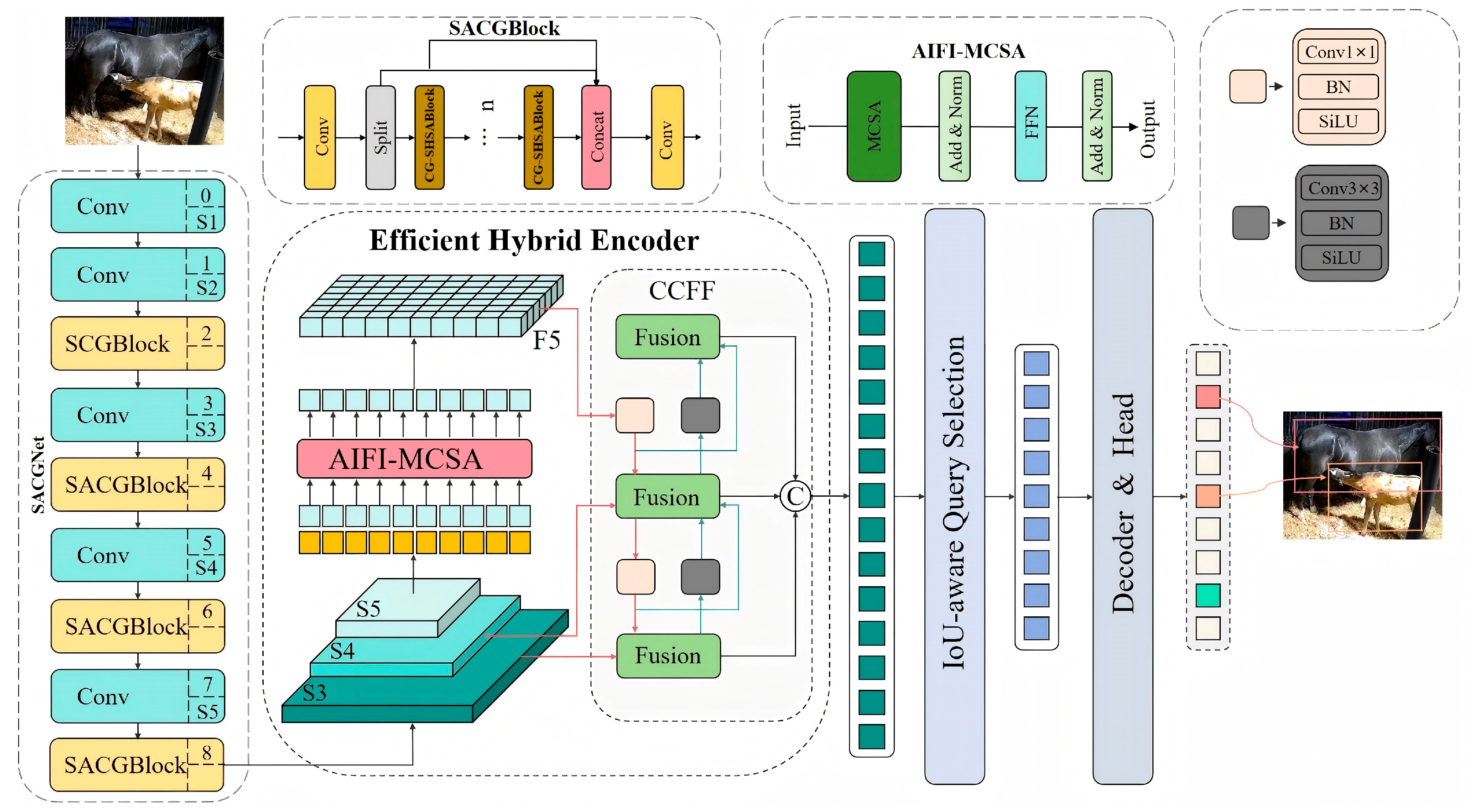
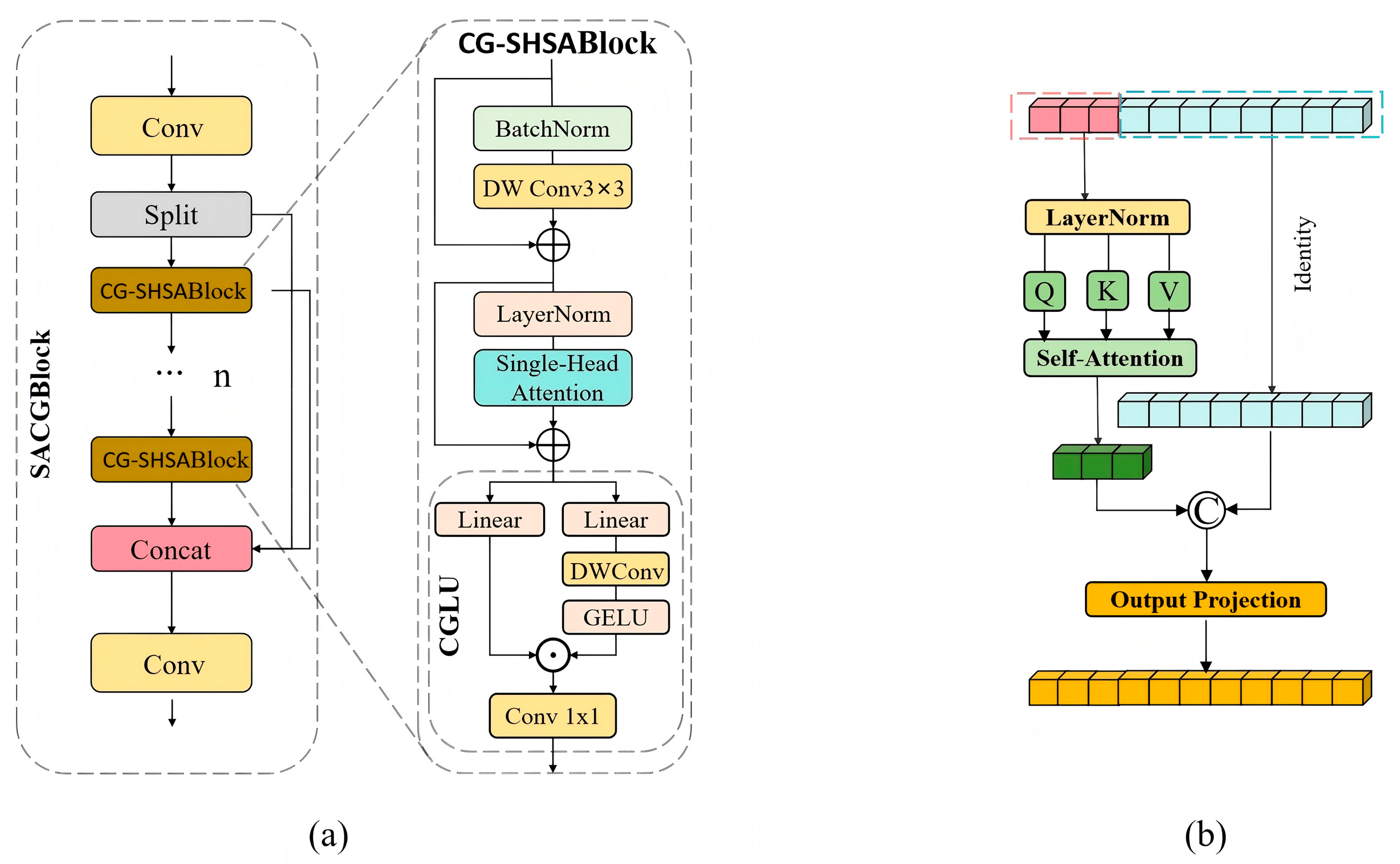
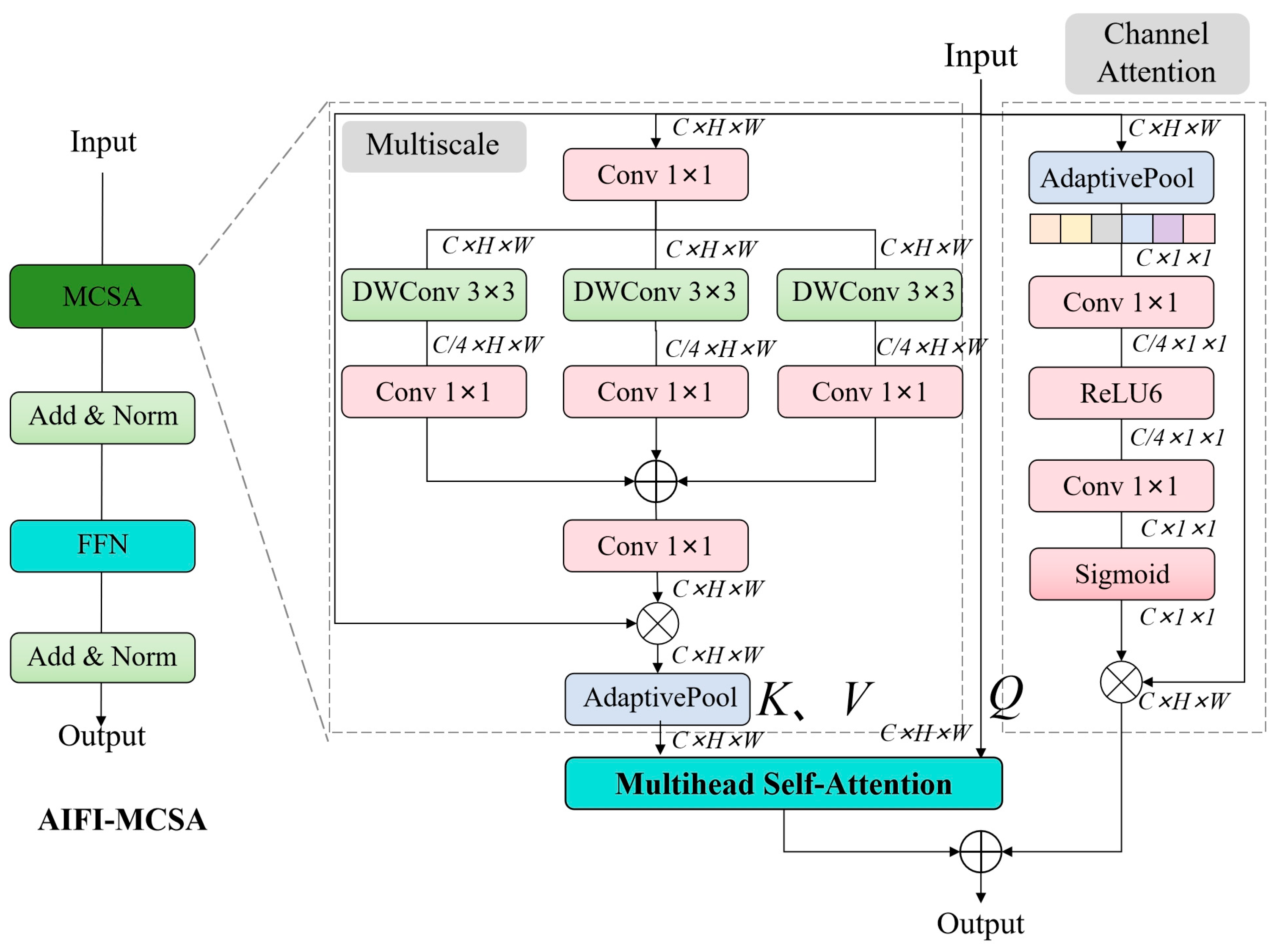
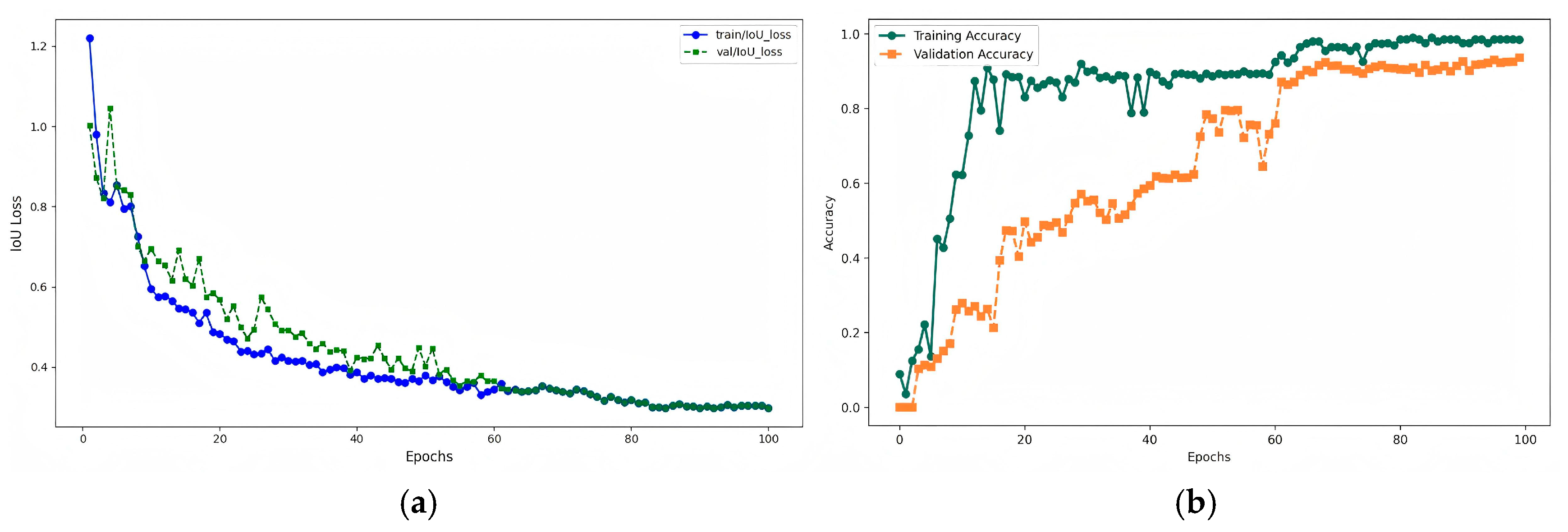
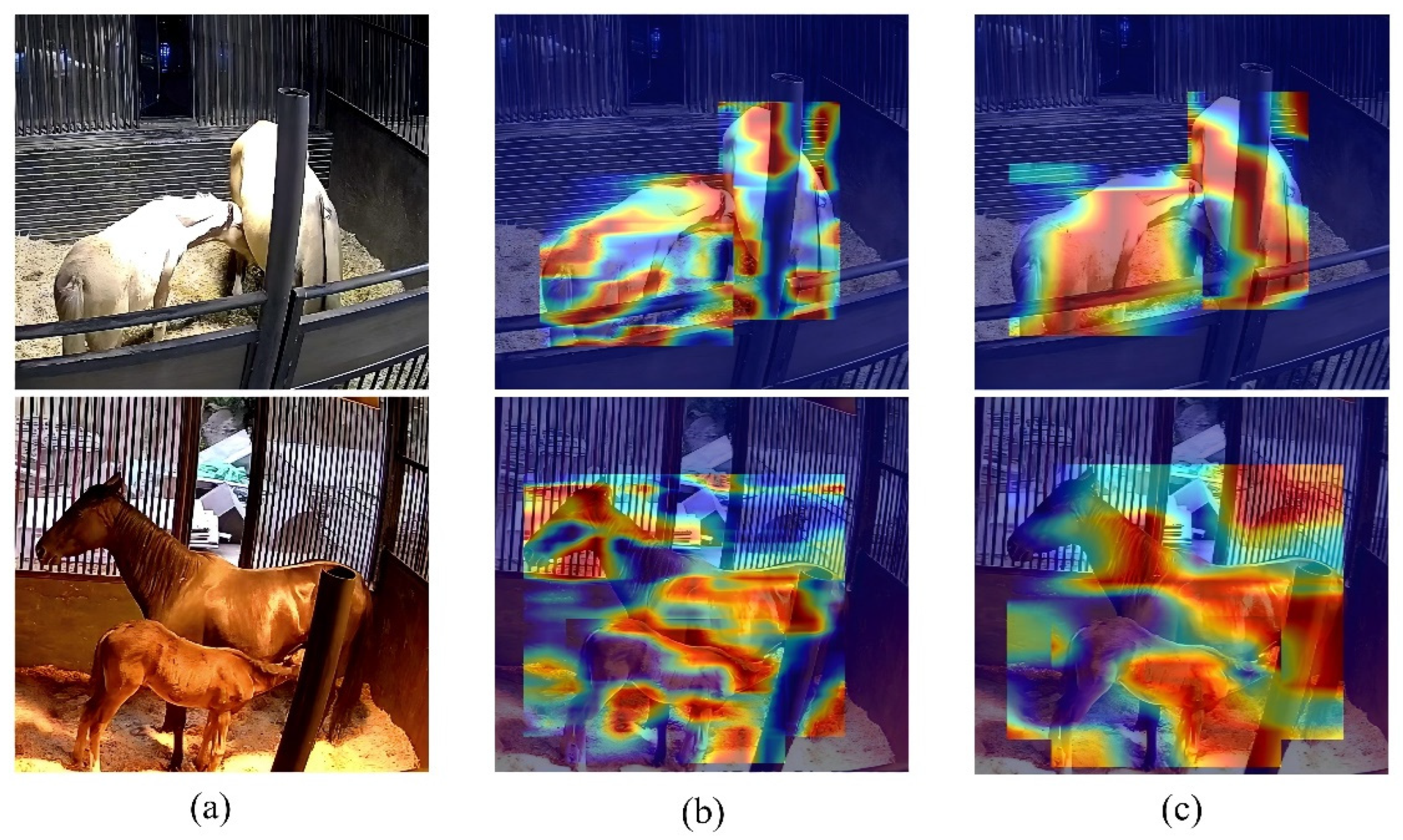
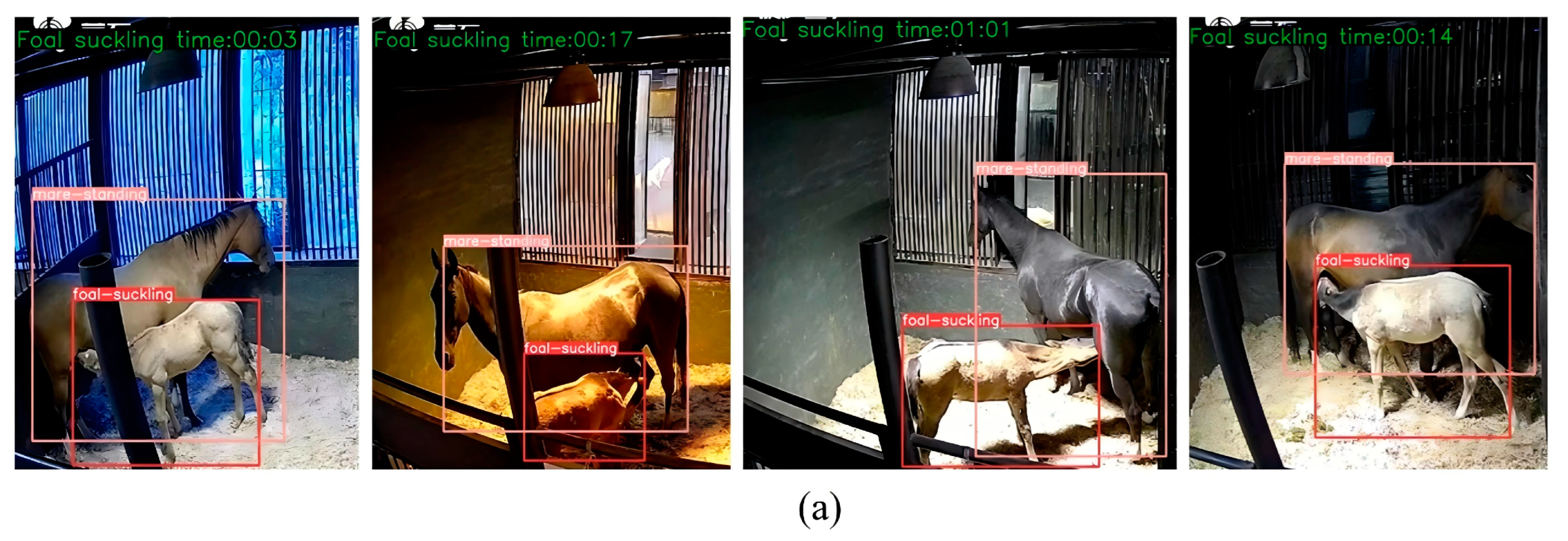



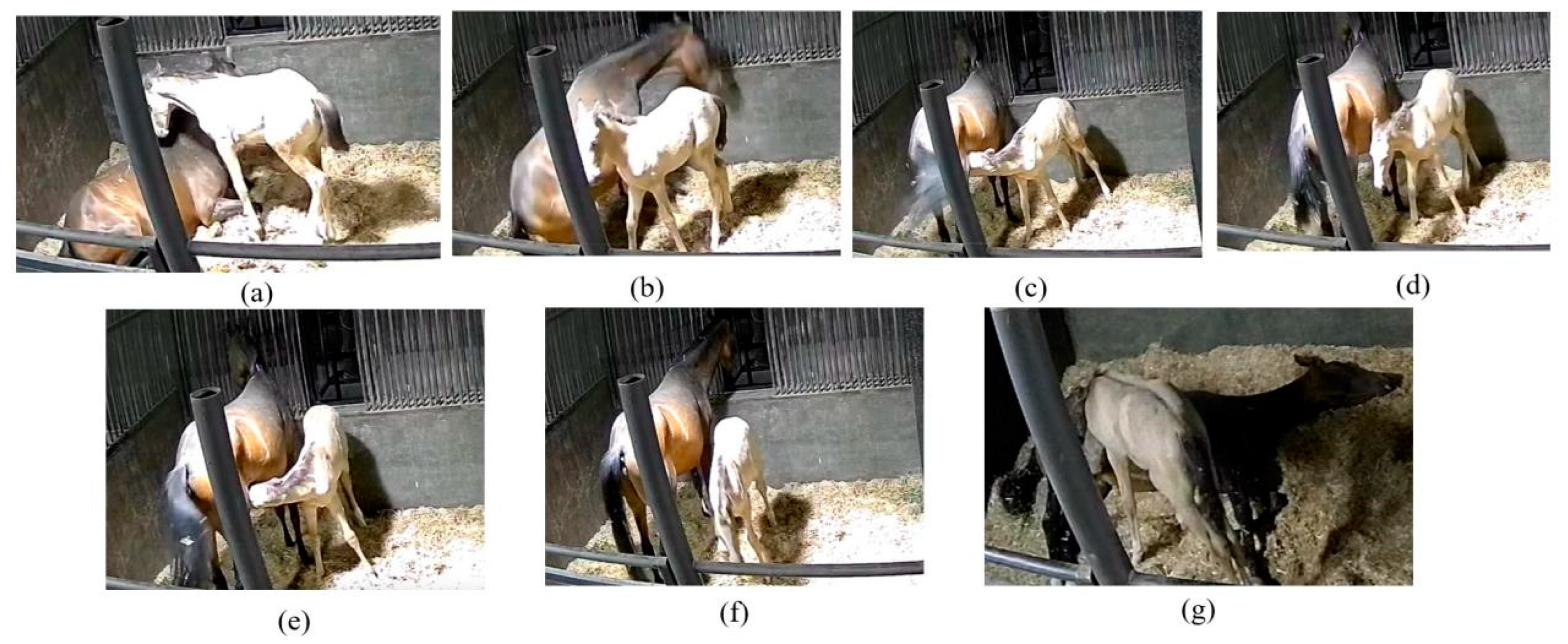
| Label | Object | Posture/Behavior | Description |
|---|---|---|---|
| Mare-standing | Mare | Posture | The four hooves of the mare touch the ground, supporting its body. |
| Foal-suckling | Foal | Posture | The foal stretches its head towards the mare’s udder, suckling milk. |
| Configurations | Parameters |
|---|---|
| OS | ubuntu20.04 |
| CPU | 12 vCPU Intel(R) Xeon(R) Silver 4214R |
| GPU | RTX 3080 Ti(12 GB) |
| CUDA Version | Cuda 11.3 |
| Memory | 90 GB |
| Deep Learning Framework | PyTorch 1.10.0 |
| Model | mAP@0.5 (%) | mAP@0.5–0.95 (%) | Weight Size (MB) |
|---|---|---|---|
| YOLOv5m | 95.1 | 73.2 | 133 |
| YOLOv8m | 95.8 | 72.4 | 135 |
| RT-DETR | 96.7 | 75.1 | 113 |
| RT-DETR-Foalnursing | 98.5 | 77.7 | 107 |
| Base Model | SACGNet | MCSA | Accuracy of Recognition | |||
|---|---|---|---|---|---|---|
| SHSA | CGLU | Mare-Standing | Foal-Suckling | mAP@50 | ||
| RT-DETR | × | × | × | 96.5 | 96.9 | 96.7 |
| RT-DETR | √ | × | × | 98.85 | 95.69 | 97.27 |
| RT-DETR | × | × | √ | 97.44 | 96.58 | 97.01 |
| RT-DETR | √ | √ | × | 98.91 | 96.83 | 97.87 |
| RT-DETR | √ | √ | 98.03 | 98.03 | 98.03 | |
| RT-DETR | √ | √ | √ | 98.98 | 98.02 | 98.5 |
| Group Number | Correct Predictions | Missed Predictions | False Predictions | Missed Rate | False Rate | Accuracy |
|---|---|---|---|---|---|---|
| 1 | 58 | 1 | 1 | 1.7% | 1.7% | 96.7% |
| 2 | 59 | 1 | 0 | 1.7% | 0 | 98.3% |
| 3 | 57 | 1 | 2 | 1.7% | 3.3% | 95% |
| 4 | 58 | 2 | 0 | 3.3% | 0 | 96.7% |
| 5 | 58 | 1 | 1 | 1.7% | 1.7% | 96.7% |
| ID | Age | Breed | Suckling Posture | ||
|---|---|---|---|---|---|
| Start Time (HH:MM:SS) | End Time (HH:MM:SS) | Duration (s) | |||
| 1 | 2 weeks | Akhal-Teke | 2:38:04 | 2:39:04 | 60 |
| 2:46:19 | 2:46:34 | 15 | |||
| 2:59:28 | 3:00:43 | 75 | |||
| 4:29:34 | 4:29:40 | 6 | |||
| 5:12:39 | 5:14:21 | 102 | |||
| 6:09:10 | 6:10:06 | 56 | |||
| 8:44:05 | 8:45:10 | 65 | |||
| 2 | 4 months | Akhal-Teke | 6:50:36 | 6:51:06 | 30 |
| 7:27:22 | 7:28:24 | 62 | |||
| 19:49:03 | 19:50:25 | 82 | |||
| 21:04:13 | 21:05:05 | 52 | |||
| 3 | 6 months | Akhal-Teke | 0:16:14 | 0:17:22 | 68 |
| 5:23:11 | 5:23:32 | 21 | |||
| 4 | 1 months | Thoroughbred | 1:10:45 | 1:11:39 | 54 |
| 4:00:54 | 4:02:33 | 99 | |||
| 20:14:29 | 20:16:02 | 93 | |||
| 21:53:18 | 21:54:58 | 100 | |||
| 22:21:50 | 22:22:58 | 68 | |||
| 23:58:28 | 23:59:38 | 70 | |||
| 5 | 2 months | Thoroughbred | 2:40:39 | 2:42:47 | 128 |
| 5:50:17 | 5:50:49 | 32 | |||
| 8:13:42 | 8:13:56 | 14 | |||
| 23:39:07 | 23:39:24 | 17 | |||
| 6 | 5 months | Thoroughbred | 3:23:41 | 3:24:53 | 72 |
| 3:45:02 | 3:45:57 | 55 | |||
| 6:39:27 | 6:39:58 | 31 | |||
| 7 | 5 months | Thoroughbred | 19:54:22 | 19:55:35 | 73 |
| 20:03:02 | 20:03:55 | 53 | |||
| 21:55:40 | 21:56:34 | 54 | |||
| 8 | 7 months | Thoroughbred | 21:32:57 | 21:33:26 | 29 |
| 22:57:19 | 22:58:29 | 70 | |||
Disclaimer/Publisher’s Note: The statements, opinions and data contained in all publications are solely those of the individual author(s) and contributor(s) and not of MDPI and/or the editor(s). MDPI and/or the editor(s) disclaim responsibility for any injury to people or property resulting from any ideas, methods, instructions or products referred to in the content. |
© 2025 by the authors. Licensee MDPI, Basel, Switzerland. This article is an open access article distributed under the terms and conditions of the Creative Commons Attribution (CC BY) license (https://creativecommons.org/licenses/by/4.0/).
Share and Cite
Liu, Y.; Zhou, F.; Zheng, W.; Bai, T.; Chen, X.; Guo, L. Recognition of Foal Nursing Behavior Based on an Improved RT-DETR Model. Animals 2025, 15, 340. https://doi.org/10.3390/ani15030340
Liu Y, Zhou F, Zheng W, Bai T, Chen X, Guo L. Recognition of Foal Nursing Behavior Based on an Improved RT-DETR Model. Animals. 2025; 15(3):340. https://doi.org/10.3390/ani15030340
Chicago/Turabian StyleLiu, Yanhong, Fang Zhou, Wenxin Zheng, Tao Bai, Xinwen Chen, and Leifeng Guo. 2025. "Recognition of Foal Nursing Behavior Based on an Improved RT-DETR Model" Animals 15, no. 3: 340. https://doi.org/10.3390/ani15030340
APA StyleLiu, Y., Zhou, F., Zheng, W., Bai, T., Chen, X., & Guo, L. (2025). Recognition of Foal Nursing Behavior Based on an Improved RT-DETR Model. Animals, 15(3), 340. https://doi.org/10.3390/ani15030340





